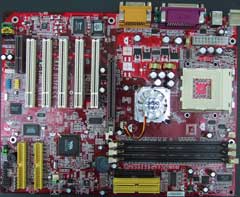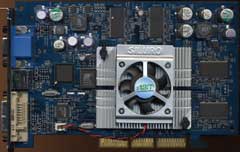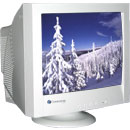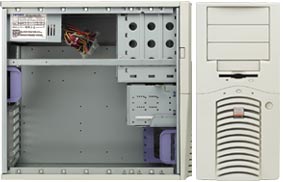
Original Link: https://www.anandtech.com/show/954
Buyer's Guide: Value Professional 3D - July 2002
by Matthew Witheiler on July 25, 2002 11:59 PM EST- Posted in
- Guides
This article was first available on the AnandTech Newsletter. Click Here to Subscribe.
We keep with our promise and today bring you the third AnandTech Buyer's Guide in three weeks. To date we have made system recommendations for value SOHO systems and the value gaming systems. Today we add to that list by looking at value systems in the professional 3D space. Let's take a look at what the AnandTech buyer's guide is:
What we will keep doing is brining you up to date system configuration suggestions on the type of system that you are interested in. Although it is impossible to suggest a single configuration for each individual in each situation, what we can and will do is provide you with recommendations towards a system setup; recommendations which can be altered appropriately for each user's specific needs. We will do what we have always done in buyer's guides: spec out a system using reliable components from reputable vendors. Remember, these prices are not necessarily the lowest prices on the web but are meant to be representative of what is out there and representative of what we think is the best solution in one of the six categories.
Changing this time around will be the format of the buyer's guides. We will maintain the six specific categories, value SOHO, value gaming, value professional 3D, high-end SOHO, high-end gaming, and high-end professional 3D, but this time around the recommendations will not be lumped together. Instead, we will be publishing one recommendation from each category weekly. We kicked off the buyer's guide with the value SOHO category and continue this week with the value gaming category. After the value and high-end recommendations are made we will do one article on a dream configuration. At this rate, new recommendations for each system will come every eight weeks so in eight weeks from today you can expect an updated value gaming buyer's guide. Not only does this keep the system recommendations fresher, it also keeps the price estimates more accurate.
Every component in a recommend system, from case to monitor, is covered. The only hidden costs are shipping costs, which can add anywhere from 5% to 10% to the total system cost depending on what you get and from where. The best way to keep shipping costs down is to order as much as possible from a single vendor or pick things up locally. Be sure to take a look at the AnandTech Hot Deals Forum to see if any AnandTech readers have posted a special deal on a piece of hardware in the recommended system. Also be sure to check out our Weekly CPU & Video Card Price Guide and our Weekly Memory & Motherboard Price Guide to see if prices have been updated since the buyer's guide was last posted.
Like before, an OS for each system is recommended but the OS price is not included in the final system price listed.
This Week
Building a professional 3D system on a budget is not an easy task. Professional 3D systems need fast CPUs, a good amount of memory, and a powerful video card to perform ideally. They also need stable components and a large monitor able to handle all the 3D tasks you throw at it. We can afford to be a bit more flexible when it comes to the price of our value professional 3D system but obviously we cant be overly generous when picking out components. The key here: mixing and matching reasonably priced pieces of hardware to create a system that can perform in 3D Studio Max, Maya, Autocad, ProENGINEER, SPEC and other professional 3D applications.
Like our other buyer's guides, the value professional 3D buyer's guide has changed quite a bit since we last recommended a system a full year ago. The vast majority of components have changed as has the price.
Value Professional 3D
Processor - AMD Athlon XP 1800+ (1.53GHz) - $79
 The AMD Athlon processors
have always done well in the professional 3D segment. In our last CPU review,
the Athlon XP 2200+ review, we found that the Athlon XP 1800+
performed quite well in our professional 3D tests. The chip was able to
out perform the Pentium 4 2.0GHz A in many cases and carries along with it a
price tag almost $100 less. Add to this the lower motherboard costs associated
with Athlon capable motherboards and you have a winner.
The AMD Athlon processors
have always done well in the professional 3D segment. In our last CPU review,
the Athlon XP 2200+ review, we found that the Athlon XP 1800+
performed quite well in our professional 3D tests. The chip was able to
out perform the Pentium 4 2.0GHz A in many cases and carries along with it a
price tag almost $100 less. Add to this the lower motherboard costs associated
with Athlon capable motherboards and you have a winner.
Truthfully it only made sense to choose an Athlon XP over an AMD Duron processor. The extra cache the Athlon XP has on die will most certainly help speed up your 3D rendering. We also decided to spring for the 1800+ over the 1700+ we recommended in the value gaming system. This was done because the extra speed offered by the 1800+ in intense professional 3D applications will certainly justify the $11 price increase. The next jump to the Athlon XP 1900+ will set you back an additional $25. At this point the marginal benefit from the increased clock speed is decreasing rapidly. Right now the 1800+ is in the sweet spot for professional 3D systems.
For more information on the AMD Athlon XP processor, check out our most recent AMD Athlon XP review.
Motherboard - MSI MS-6380E KT3 Ultra - $65
The price of our recommended KT333 motherboard solution has fallen by about $10 this week, making the deal even better. The MSI MS-6380E KT3 Ultra is the same KT333 based motherboard we recommended for our value gaming setup. We knew that the performance increase associated with using a KT333 chipset over a KT266A chipset would be worth it for the small price difference. Here is what we had to say about the MSI MS-6380E KT3 last week:
Next we were left trying to decide what KT333 motherboard we should use. In our recent KT333 roundup we found that many of the KT333 solutions out there were similar. In fact, we were not able to select a motherboard in the group worthy of the AnandTech Editor's Choice gold award. What we decided to do was go through the list of KT333 motherboards that we had and choose one based on features and price.
We went out searching for a KT333 motherboard in the $60-$80 price range that included both integrated 6 channel audio and integrated LAN. Unfortunately we could not find a suitable motherboard in this price range that offered both 6 channel integrated audio and integrated LAN. We were therefore forced to chose which feature we would rather have on the motherboard.
While a fast and reliable LAN card typically only costs about $20, a good 6 channel audio solution starts at $50 and up. With this in mind, we decided to go with a motherboard that offers integrated 6 channel audio as opposed to integrated LAN since it would save us money in the overall system price. We chose to go with the MSI MS-6380E KT3 Ultra not only because of its price but also because because it picked up the AnandTech Editors Choice Silver award in our KT333 roundup.

You can read more about the MSI KT3 Ultra in our KT333 roundup and more about the KT333 chipset in general in our VIA KT333 article.
Memory - 512MB Mushkin PC2700 DDR SDRAM - $169
Memory prices have risen fairly noticeably this week, putting the price of our memory $45 dollars more than it would have cost us last week. We choose Mushkin memory again this week because of both its quality and its price. The 512MB of PC2700 DDR SDRAM from Mushkin cost us $30 less than it would have from other reputable memory manufacturers. If you can find better deals on memory out there from name brand manufacturers, by all means go with it.
We chose to outfit our value professional 3D system with 512MB of memory because the applications that such a system will be running are memory hungry. There is no longer a price advantage with getting the memory split over two sticks instead of one. In fact, two 256MB modules of the same memory will actually cost you about $10 more than going with one stick.

Video card - NVIDIA GeForce4 Ti 4200 64MB - $140
Since we can afford to be a bit more lenient with price in our value professional 3D system we chose to outfit it with a GeForce3 Ti 4200. We knew that putting a DirectX 8 card in our value professional 3D system was a must as it is only with a DirectX 8 ready card that we can take advantage of vertex and pixel shaders. The professional 3D NVIDIA cards that include this functionality, the Quadro4 XGL cards, are priced far to high to find their way into a value system of any sorts. Don't fret: the hardware antialiased lines, hardware overlay planes, and two-sided lighting that the Quadro cards offer wont be missed much but the $400 or so that you save by going with the Ti 4200 would be.

We would suggest you stay away from previous generation Quadro based cards. Although prices of Quadro2 cards have fallen quite a bit from their prices a year ago, the cards miss out on the advanced GeForce4 features such as DX 8 compatibility and an enhanced T&L engine. When deciding what GeForce4 Ti 4200 to go with, just stick with the least expensive one you can find. We saw in our GeForce4 Ti 4200 roundup that all 4200 cards are created equal.
The other card you may consider going with is the card we placed in our value gaming system, the ATI Radeon 8500 LE. The 8500 LE will not be as fast as the GeForce4 Ti 4200 but it will cost you almost $50 less.
Be sure to check out our GeForce4 Ti 4200 roundup for more information about the NVIDIA GeForce4 Ti 4200.
Monitor - Cornerstone C1035 - $499
 Just
like 19" monitor prices, 21" monitor prices have been falling the
recent months. We decided that the extra money that a 21" monitor will
cost you is worth it on a professional 3D system such as this one. We chose
to recommend the Cornerstone C1035 due to our personal
experience with it. During our testing we were very pleased with the monitor
and found that it was able to provide quite the bang for the buck.
Just
like 19" monitor prices, 21" monitor prices have been falling the
recent months. We decided that the extra money that a 21" monitor will
cost you is worth it on a professional 3D system such as this one. We chose
to recommend the Cornerstone C1035 due to our personal
experience with it. During our testing we were very pleased with the monitor
and found that it was able to provide quite the bang for the buck.
You are fairly safe going with a 21" monitor from any major monitor manufacturer. Just make sure that it can display a resolution of at least 1600x1200 at a refresh rate of 70Hz or above.
For more information on the Cornerstone C1035, check out the review we did on the monitor.
Case - Antec SX630 - $65
After the comments we got in our value SOHO system buyer's guide, we changed our case recommendation to the Antec SX630 for our value gamers system. The value professional 3D gets the same case which offers expandability, good airflow, and a nice price.
The SX630 features many of the same features present on our previous case choice, the Antec Value Line KS388, but offers additional cooling. The SX630 is a mini tower system that includes 8 drive bays (five 3.5" bays and three 5.25" bays), seven expansion slots, a swing-out side panel, and an 80mm rear case fan standard. The SX630 can also accept two front mounted 80mm case fans. The SX630 also comes with an AMD approved 300 watt power supply.

Sound card - Integrated 6 Channel Avance Logic ALC650 - "Free"
Thanks to Avance Logic's new ACL650 AC'97 codec, a discrete sound card is no longer necessary. The MSI 6380E KT3 Ultra motherboard we chose to power our professional 3D system makes use of the ACL650, providing a very low cost 6 channel audio that provides audio functionality not previously available in an integrated audio solution.
Avance Logic's software allows you to remap the three 1/8" jacks on the KT3 Ultra to handle front, rear and LFE outputs. Because of this, these three jacks enable 5.1 channel analog outputs without the use of any additional brackets. The audio quality of this solution should be just about as good as a high end discrete audio card with a price much more attractive: free. Sure, audio playback may not be of utmost concern in a professional 3D system but it is hard to beat a price that is free.
Check out our page covering on-board audio in our KT333 roundup for more information.
Speakers - Generic - $20
Because sound is not the most important thing in most professional environments,we chose to outfit our value professional 3D system with a set of speakers that doesn't really do the integrated audio justice. Any pair of stereo speakers at your local computer store will make do for now. If you are interested in getting a higher end audio system, try the Logitech Z-540s. They will cost about $40 more than the generic stereo speakers but will sound a world better.
Ethernet: Linksys EtherFast 10/100 - $20
Since our motherboard did not offer integrated ethernet, we had to chose an add-in card to provide broadband connectivity. We use Linksys products here in the AnandTech lab all the time and have never been disappointed. Besides, at just $20 for a card with full support directly from the manufacturer under the major OS's, including Linux and Windows 2000, the EtherFast 10/100 is a deal that's impossible to pass up.
Hard drive - Maxtor DiamondMax D740X 6L040J2 40GB - $65
Again we stick to the same hard drive recommendation we made in our value gaming system buyer's guide.
The Maxtor DiamondMax D740X drive that we recommend today is a high performance 7200rpm drive that is able to offer speed at a good price. Larger versions of the D740X are available for about $20 more and offer the same performance as the 40GB model chosen here. In a system where performance is key, such as this one, we recommend that you stick with a 7200rpm drive as the hard drive remains one of the largest PC bottlenecks.
CD-ROM/CD-RW/DVD-ROM - Name brand 40X - 50X CD-ROM - $30
Our recommended optical solution is the same one that the previous two value system received. A DVD drive or a CD-RW drive is just not necessary in a machine being built on a budget. Again, we suggest going with a brand name CDROM drive, not just the cheapest one available. We have seen no-name CDROM drives choke when trying to read less than perfect discs and not perform as advertised even under ideal situations. Try going with Acer, ASUS, Creative Labs, Toshiba, or Teac.
If you are looking for good CD-R or CD-RW functionality, those drives can be had for about $25 more but feature lower read speeds.
OS - Microsoft Windows XP Professional - $275
Windows XP Professional is not only the clear operating system choice for those wanting to get work done in the high stress environment of professional 3d applications. The OS offers great stability and performance while maintaining compatibility with almost every application imaginable. In addition, the built in DirectX 8 functionality ensures that the current generation games will run flawlessly. Those looking for an alternate OS could go with a recent Linux build for a fraction of the cost but may be disappointed with the limited number of 3D games such a setup would be able to can play.
You may be able to find an OEM copy of Windows XP Professional out there for significantly less. If you are building the machine from scratch, by all means go for it.
Bottom Line: $1152 (without software)
Summary
| Value SOHO |
Component |
Price |
CPU
|
AMD
Athlon XP 1800+ (1.53GHz) |
$79 |
Motherboard |
MSI
MS-6380E KT3 Ultra |
$65 |
Memory |
512MB
Mushkin PC2700 DDR SDRAM |
$169 |
Video
Card |
GeForce4
Ti 4200 64MB |
$140 |
Monitor |
Cornerstone
C1035 |
$499 |
Case |
Antec
SX630 |
$65 |
Sound
Card |
Integrated
Avance Logic ALC650 |
$0 |
Speakers |
Generic |
$20 |
Ethernet |
Linksys
EtherFast 10/100 |
$20 |
Hard
Drive |
Maxtor
DiamondMax D740X 6L040J2 40GB |
$65 |
Hard
Drive Controller |
Integrated
KT333 |
$0 |
CD-ROM |
Name
brand 40X - 50X CD-ROM |
$30 |
CD-RW |
None |
|
Bottom
line |
|
$1152 |
The value professional 3D system ranks as the most expensive of the three value systems we have ranked in the past three weeks. Thanks to the additional memory and rising memory prices, the larger monitor, and the more powerful video card, the value professional 3D system is $400 more than the value gaming system we looked at last week. Although the price may sound hefty, the value professional 3D system of today is still $113 less expensive than the value professional 3D system we configured a year ago.







